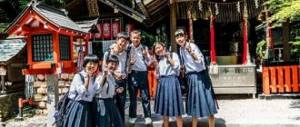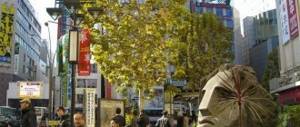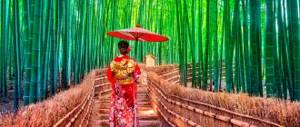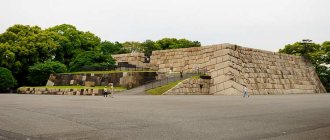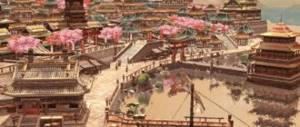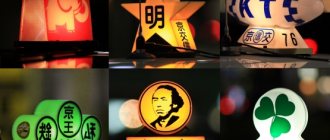Author:
Galina
14:51 | 14.01.2017
Heading:
Japan
700
400
When planning a trip, rational people try to find out as much as possible about the destination in order to take the necessary things and not get caught in the rain or hurricanes. The weather in Tokyo is not always pleasant for tourists. There are rainy and cold periods here. The city is located in the subtropical zone. Additionally, it is “warmed” by the ocean, softening the weather compared to mainland territories at the same latitude.
General information about the weather in Tokyo (climate in Tokyo)
| Content |
| –> Current month |
| –> The warmest, coldest, sunny and snowy |
| –> Weather by month (table) |
| –> Temperature by month (graph) |
| –> Humidity by month (graph) |
| –> Wind rose |
The site contains information about the weather in the city of Tokyo since 2014. This page tells about the weather in Tokyo
in general, that is, about
the climate in the city of Tokyo
.
More detailed weather data in Tokyo
can be obtained, for example, from the following links:
- Weather in Tokyo in November,
- Weather in Tokyo in November 2021,
- Weather forecast in Tokyo
Each page contains detailed information about temperature, humidity, wind rose in the city of Tokyo
and other climate parameters in the corresponding month. Another city and another date can be selected in the site menu.
Hot Summer
The climate of the metropolis differs from the general climate in the country. Scientists have found that the average daily temperature is influenced by buildings and communications, and people’s behavior also makes its contribution. Thus, in Tokyo this figure is 4 degrees higher than in the rest of the region. Summer in the capital is long and stuffy, if you do not take into account the humid season. It ends almost in November. Spring doesn't come all at once either. All its signs can clearly be seen only in early May.
The heat in Tokyo is different from what residents of the continent are used to. It is wet, which makes it more difficult to bear. People find it difficult to breathe, have no appetite, and no desire to move. You need to get used to this season so as not to suffer from the stuffy, sweltering heat. The Japanese and tourists resort to green tea or fruit water; a favorite summer treat is kakigori. It is advisable to keep and consume drinks chilled.
Light clothing is encouraged to help cool the body. Public areas are usually equipped with air conditioning. In the summer, the Cool Biz campaign begins at enterprises and organizations, which, on the one hand, allows workers to endure the heat more easily, and on the other hand, use air conditioners less often. This is done in order to save electricity, the supply of which is limited in Japan, and to reduce the negative impact of air conditioners on the environment.
The crowd of people in the metropolis makes the heat worse. Roads and buildings absorb heat from the sun's rays and prevent people from resting at night. They release the accumulated heat to the surrounding space. Scientists have noticed that the average daily temperature rises by half a degree every year. People on city streets are increasingly suffering from heatstroke. By the way, the operation of a large number of air conditioners also does not contribute to the coolness outside the windows of the rooms in which they refresh the air.
Local residents are used to the sweltering season. They protect themselves with traditional green tea and comfortable clothes. During hot weather, handkerchiefs and napkins are sold everywhere to wipe away sweat. Interestingly, there are no deodorants in Japan.
No, after all, there are deodorants, but not quite in the form that is familiar to us, although the classic ones are also available for sale. The Japanese, unlike Europeans, tolerate heat more easily and practically do not sweat, so local residents do not need them, and foreigners bring these personal hygiene products from their homeland.
The Japanese government is concerned about the constant warming of the climate and, as a result, an increasing number of people suffering from the effects of heat. A temperature of 35° no longer surprises anyone. Combined with high humidity, this is an explosive mixture for the human body. The risk group consists mainly of children and the elderly.
Moreover, on the eve of the 2021 Olympics, the authorities are thinking about how to ensure a comfortable stay for people on the city streets and indoors. In this regard, new technologies and systems are being developed. In 2021, islands of fresh and cool air, developed by Panasonic, were installed in Tokyo; climate and cooling are created using environmentally friendly air conditioning.
Warmest, coldest, sunny and snowy month in Tokyo
As weather statistics
,
the warmest month in Tokyo is August
with an average temperature of +27.5°C.
The second place is July (+26.4°C), the third is September (+23.8°C). Accordingly, the coldest month in Tokyo
is January.
The average monthly temperature in January is only +6.2°C. The city of Tokyo has the most sunshine
in January.
Thus, January is the sunniest month in the city of Tokyo
.
Let us know if this table is useful to you? Useful table (2253) No (491)
| The warmest | |
| August | +27.5°С |
| July | +26.4°С |
| September | +23.8°С |
| The coldest | |
| January | +6.2°С |
| February | +7.2°С |
| December | +8.3°С |
| More sun | |
| January | 14 days |
| December | 13 days |
| February | 12 days |
| More snow | |
| January | 0 days |
| December | 0 days |
| February | 0 days |
Characteristics of the Japanese climate
Since the Japanese archipelago is surrounded by seas on almost all sides, water has a great influence on the climatic conditions of the state. Thus, on the islands of Shikoku, Honshu, and Hokkaido, the climate is classified as temperate marine.
Subtropics can be found on the island of Kyushu. Ryukyu also has a subtropical environment. The tropics are found on the southern side of Ryukyu, as well as on all the islands close to this part of Ryukyu.
The harshest climatic conditions are found high in the mountains of the archipelago, as well as in northern Hokkaido.
The temperate climate in Japan is characterized by cold winters, foggy springs and short summers. Where the subtropical zone dominates, the hot summers are softened by strong sea breezes, and winter days become warmer and milder.
Most of the territories of the Land of the Rising Sun are classified as having a temperate climate. It should be considered as the main climatic zone. The average annual precipitation for the country is 1500 mm.
Weather in Tokyo by months (table)
Below is the table of weather in Tokyo by month. In the table you will find such climate parameters in the city of Tokyo, such as the average temperature in the city of Tokyo by month
, average humidity in Tokyo city by month, average wind speed in Tokyo city by month,
number of sunny days in Tokyo city
by month,
number of rainy days in Tokyo city
by month and other information.
Let us know if this table is useful to you? Useful table (3950) No (668)
| Month | average temperature | Average humidity | Wind speed | Amount of days | ||||
| Clear | Cloudy | Mainly cloudy | Rain | Snow | ||||
| January | +6.2°С | 54 % | 3.8 m/s | 14 | 13 | 2 | 0 | 0 |
| February | +7.2°С | 56 % | 4.3 m/s | 12 | 14 | 3 | 1 | 0 |
| March | +10.7°С | 61 % | 4.5 m/s | 11 | 15 | 3 | 1 | 0 |
| April | +14.8°С | 66 % | 4.3 m/s | 10 | 15 | 4 | 1 | 0 |
| May | +19.8°С | 70 % | 4.5 m/s | 10 | 17 | 2 | 1 | 0 |
| June | +22.5°С | 78 % | 3.7 m/s | 4 | 22 | 3 | 0 | 0 |
| July | +26.4°С | 82 % | 3.7 m/s | 5 | 21 | 4 | 0 | 0 |
| August | +27.5°С | 79 % | 4.1 m/s | 4 | 21 | 4 | 1 | 0 |
| September | +23.8°С | 80 % | 3.6 m/s | 6 | 17 | 5 | 2 | 0 |
| October | +18.8°С | 74 % | 3.6 m/s | 7 | 17 | 5 | 1 | 0 |
| November | +13.7°С | 68 % | 3.4 m/s | 9 | 16 | 4 | 1 | 0 |
| December | +8.3°С | 58 % | 3.7 m/s | 13 | 14 | 3 | 0 | 0 |
Ideal time to vacation in different parts of Japan
| Sapporo and Hokkaido Island | November - May, October-November |
| Tokyo and Honshu Island | April-May, October-November |
| Islands of Kyushu and Shikoku | March - May, October - November |
| Okinawa and the Ryukyu Archipelago | April - October |
Whichever Japanese island you're aiming for, we'll help you figure out when is the best time to travel to Japan and when plane tickets are cheaper.
When searching for cheap air tickets, a useful Skyscanner tool will come in handy, with which you can determine when it is most profitable to fly to Japan from your city.
Temperature in Tokyo by month (graph)
The temperature in Tokyo varies depending on the month from 6.2°C to 27.5°C. Moreover, the minimum temperature in the city of Tokyo is observed in January, the maximum temperature in the city of Tokyo is usually in August.
The graph of average temperatures in the city of Tokyo by month is presented below:
Let us know if this chart is useful to you? Helpful chart (1910) No (295)
How to deal with the cold in winter in Japan?
Over time, I developed my own tactics for dealing with the cold for each time of day. To be fair, it should be noted that the tactics are not entirely mine, but only in their extreme moments. Most of her techniques are, of course, borrowed from the locals.
We don’t sit at home, but “go out into the world”!
In winter, when the temperature outside the window drops to sub-zero levels, in the evenings it is best to be outside the walls of your unheated home. For example, in a cafe or at the cinema , or while walking around huge warm shops .
In supermarkets I once noticed luxury electric massage chairs that were never empty. They were specially placed so that one of the married couple, while waiting for their half with purchases, would while away the time with a massage.
Taking a closer look at the most passionate armchair lovers, I made the discovery that most of them were local homeless people. I, too, sometimes managed to take possession of the leather miracle of Japanese technology for about ten minutes. My conscience did not allow me to stay longer.
Have you been to a live sumo wrestling competition No? Be sure to go - it turns you on and excites you, especially if you buy a seat closer to the arena. And note - it’s warm there!
It’s also a very good idea to sign up for a Japanese sports club like Konami, which for just fifty monthly membership dollars will take you to the very paradise of Japanese sports comfort.
This coziness includes dance classes, learning some form of swimming (in a warm pool), meeting new people, fitness, wet or dry sauna, and swimming in an onsen hot spring or a national sento bath right within the walls of this club.
After the sauna, you can wash and freshen up in the club’s most pleasant and exemplarily clean shower with a wide range of products for the body and head. There are rumors that our fellow citizens are quietly stealing these same funds, which I think is out of the question.
The procedure for signing up for the club itself is interesting. For example, if you have a tattoo, they won’t hire you. Once I took my friend to the club, but to his utter disappointment they didn’t take him, without really explaining the reasons.
By the way, as a good one-time (or for some, reusable) option, consider having dinner at a themed cafe like the Maid Cafe in the Akihabara quarter of Tokyo, which is located in the special Chiyode area. I have already written about him earlier.
In a word, in winter our brother gaijin or foreigner needs to learn to spend the evenings in the right places - that is, in the warmth.
How to stay warm in the evening and at night at home
My personal methods of heating at home, or rather one of them, stand apart. Now you will understand why. And so it’s late evening outside and those same ominous -5C°. Introduced?
And if I had to stay at home, then for this case I purchased a small and economical fan with an electric spiral . While sitting at the table, having dinner or studying, you could direct it to your freezing sides.
the means of protecting against the cold at night from the Japanese. They are simple and democratic. We simply warm up the body in a hot bath or shower and, having steamed and accumulated heat, jump under a warm and light Japanese futon duvet. One was enough for me. Some use more.
Winter morning is the most shocking time, literally and figuratively. During the night, the temperature in the room sometimes drops to five degrees. I set the winter-summer air conditioner I purchased back in the summer to turn on automatically in the morning in advance. But it doesn't help much. The icy air burns your body.
And here I do something that not everyone will understand. I go to the bathroom and stand under a strong stream of cold water. Slowly I raise the stream from my feet to my chest. My body immediately becomes very tense, but with effort I relax it. One or two minutes was enough. I'm starting to rub myself. Thick steam comes from my body. I get dressed and life seems fabulously wonderful.
What helps an ordinary Japanese pass the winter evenings?
In Japan, there are additional types of heating worthy of attention, such as Kotatsu - a low table with a stove under the tabletop. There are gas and oil stoves .
There is also kairo - bags for gluing to clothing with a special powder that begins to heat up in the air. But I didn’t have the chance to take advantage of all this because by that time I had already gotten used to the cold and almost didn’t feel it.
Any final words? Winter in the central part of the country is mild, but if you generally do not like sub-zero temperatures, then go south. There, even in “harsh” January, the average temperature remains around 15C°. Comfortable weather will be guaranteed to you!
Humidity in Tokyo by month (graph)
Humidity in Tokyo varies depending on the month from 54% to 82%. At the same time, the minimum humidity in the city of Tokyo is observed in January, the maximum humidity in the city of Tokyo occurs in July.
The graph of average humidity in the city of Tokyo by month is presented below:
Let us know if this chart is useful to you? Useful chart (1532) No (255)
Japanese spring (March, April, May)
Spring warmth comes to Japan quickly in mid-March. Experienced travelers note that spring in Japan is the best time to travel around the country.
In Sapporo in Hokkaido in March the daytime temperature reaches 7 degrees Celsius. On other islands, the temperature in the middle of the month is 11-13 degrees Celsius. In the south of the state the thermometer rises to 17 degrees.
In April, sakura begins to bloom. The heat becomes stable, morning fogs disappear, and the amount of precipitation decreases. For example, in Tokyo in April the daytime temperature reaches 18 degrees, and at night the temperature does not drop below 10 degrees Celsius.
May in the country feels like real summer. Sunny, hot and comfortable - this is how you can characterize the Japanese islands in May. In Hokkaido, in May, the rains stop altogether; in Central Japan, spring winds and coastal breezes subside.
When is the best time to go to Kyushu and Shikoku?
Kyushu and Shikoku are already subtropical. There is almost no winter here, and in summer it is hot and too humid. Autumn brings joy with cool breezes, bright colors and, of course, falling prices.
Sakura here begins to bloom in March, when warm, clear weather and comfortable humidity set in on the islands. The beach season at local resorts begins in May. In August and September, typhoons can hit the coast, and tourists are a dime a dozen. Therefore, the best time to travel to Shikoku and Kyushu is from March to May and October to November .
Cheap flights to Kyushu
Cheap flights to Shikoku
Tourist seasons and places to visit
In Japan there is no concept of “low season” ; people come here to relax at any time of the year, but the vacation will be different, because the seasons in Japan are very different from each other, and they come abruptly.
And yet, summer is less suitable for tourism than other seasons - it is the rainy season in Honshu at this time, and it can be both stuffy and rainy. The sky is constantly overcast, the humidity level is high, which makes everything damp and mold appears - and therefore you may not like Honshu in the summer; even the inhabitants of the island themselves most often go on vacation to other places at this time of year. But you shouldn’t completely abandon the idea of going to Japan in the summer - it is at this time of year that the largest number of festivals and holidays are held, so it will be interesting! This is a good time to travel around the Japanese countryside and go on vacation in the mountains.
The Japanese themselves distinguish as many as six seasons of the year: in addition to the four usual ones, this is also the tsuyu season, which translates as “plum rains,” which lasts about a month and a half, and the season of autumn transparency or Japanese clarity - late autumn until winter. In Japan, late autumn is strikingly different from ours, and it has such poetic names for a reason - for many Japanese, its days are absolutely favorite. It is at this time that the country is filled with red momiji leaves, creating beautiful views that can compete with sakura.
Winter is usually dry and snowless. Sometimes it rains, but usually the sky is clear. It’s not cold here at all, and you can freely walk around the streets in a sweater. Of course, in winter the scenery in the area is not so good, because the trees lose their leaves and the area is not covered with emerald grass - but still, being on the main island of Japan in winter is very pleasant.
But the best times of the year to travel to Tokyo and Honshu are spring and autumn, because in the spring this country is painted green and pink, and in the fall yellow and red - both look very beautiful. From Tokyo you can go to the outskirts of Fuji - there are many hot springs and the spirit of a real Japanese outback.
It is wrong to imagine Japan as a country consisting entirely of megacities - more than 70% of its territory is occupied by sparsely populated mountains and volcanoes. There are only 108 active volcanoes in the country, and the main one is one of the symbols of Japan, Fuji. This volcano annually attracts many tourists both from Japan itself and from beyond its borders, because there is really something to admire here. Kyoto is another tourism center; there are always a lot of guests here, most of them the Japanese themselves. After all, Kyoto is an ancient capital, now famous mainly for its beautiful temples - there are hundreds of them in the city.
There are still many beautiful cities and castles in Japan that are worth visiting: Osaka and Nara, Nagoya and Hiroshima, Kobe and Saitama, Himmeji Castle and Kumamoto Castle, and there are so many Shinto shrines here! It’s impossible to list all the attractions of this country; they are here literally at every step.
The Japanese themselves go on summer holidays to the beaches of Okinawa, a paradise lost in the ocean. Okinawa is called the “treasure islands” - it is summer all year round, but not stiflingly hot, but pleasant. Truly a heavenly place! At the same time, although people come here mainly for the sea, here you can also find many attractions: medieval castles and villages, royal gardens and sacred places - the real spirit of the Japanese Middle Ages, and all this in a tropical atmosphere!
Winter holidays
From the edge of eternal summer - straight to winter holidays! Once again, Japanese contrasts are emphasized by the fact that such different natural areas coexist in such a small country: people most often go Hokkaido There is all the infrastructure for this, because the Japanese themselves usually vacation on this island, and the majestic winter landscapes of the island will not leave anyone indifferent.

